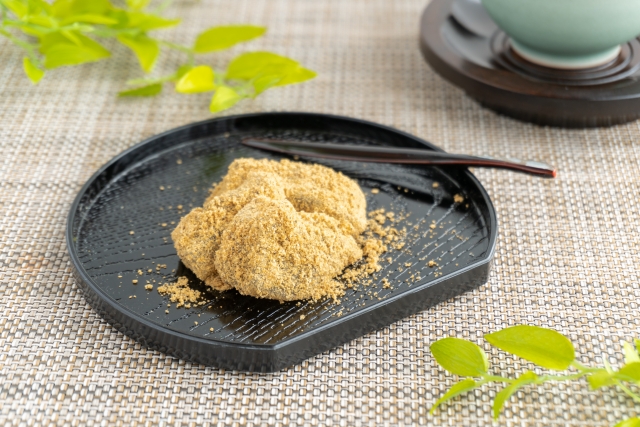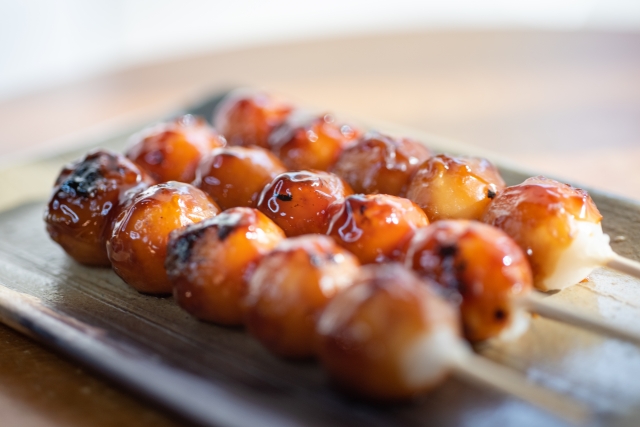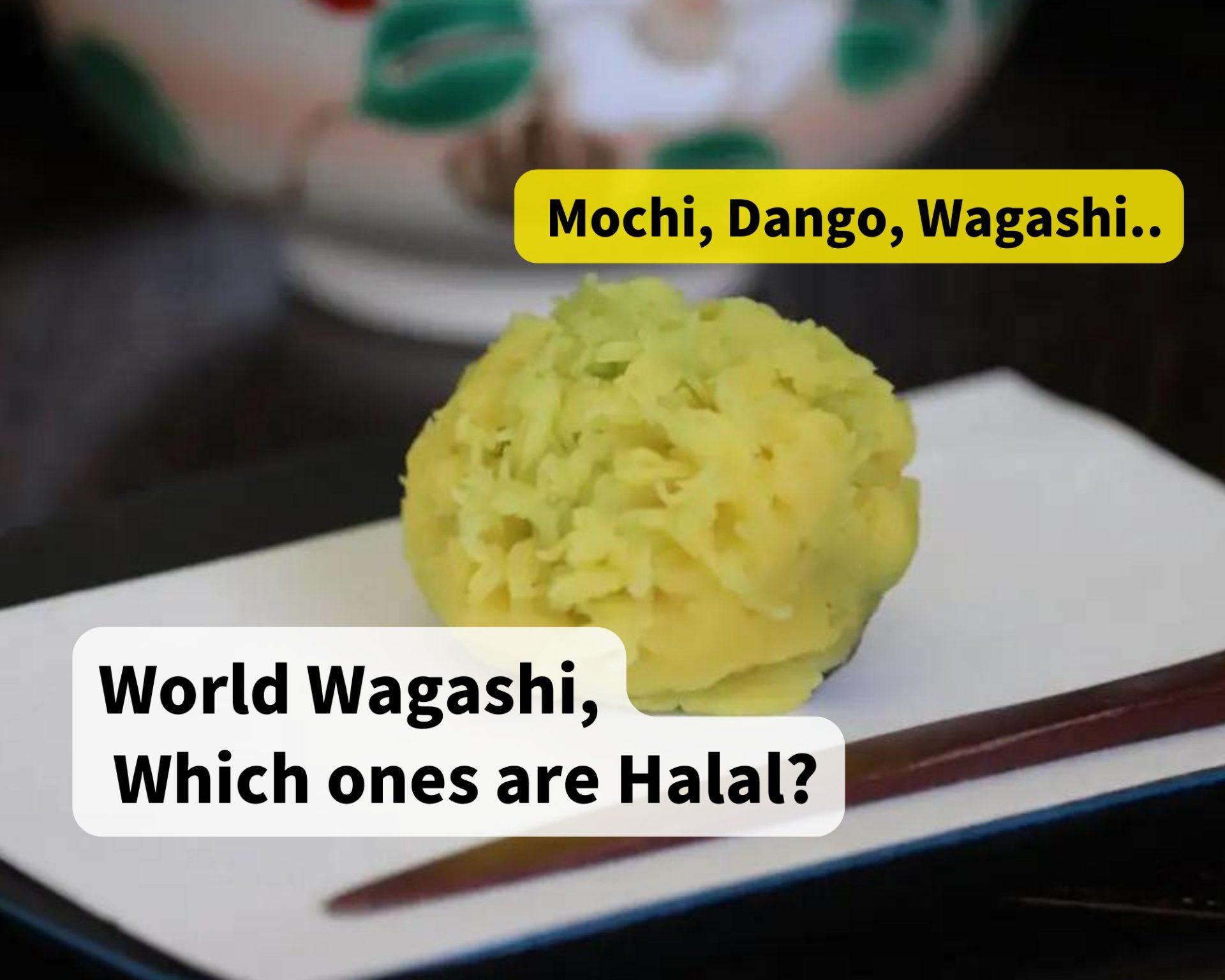Not only authentic cuisine.
Japanese cuisine is a part of important cultural assets that we have, and many tourists are looking forward to having them when traveling to Japan. It is not only limited to posh and luxurious dishes but also casual, light snacks.
But what about Japanese sweets, Wagashi (和菓子)? To your surprise, some of Japanese Wagashis can contain animal ingredients such as gelatin or alcoholic seasonings, however, only a little about this is known.
Japanese traditional sweets can be enjoyed at the best quality only when you are in the country, and what is great about the sweets is that many of them can be Halal or Muslim-friendly!

What are the features of Wagashi?
For most of you, Wagashi is a sweet that has bean paste simmered with lots of sugar. It sometimes has a chewy rice cake called Mochi.
Yes, this is very true. But did you know that many Wagashi have been altered to meet the demand of Japanese people who are more health-conscious, tend to like western foods? Japanese sweet is becoming less sweet and there are more products that are using butter, cream or fruits.
Let’s see major Wagashis and how it is made to find out if they are Halal or not.
Halal Wagashi
We introduce only very basic ingredients, so that the recipes and ingredients can be changed depending on the shop. Please check if the sweet is Halal or not by yourself.
Wagashi (和菓子) / Jo Namagashi (上生菓子) / Nerikiri (練り切り)
This is the most basic Japanese sweet, which literally means “Japanese sweets”. However, the name is very confusing, because other types of Japanese traditional sweets are also called as Wagashi.
To differentiate other Japanese sweets, it is sometimes called as Jo Namagashi (上生菓子) or Nerikiri (練り切り). Though they have a slight difference in the ingredients, they are basically the same things.
Wagashi always has a shape of plant or flower of that season, and they are always served in Japanese Tea ceremony. With this Wagashi, we can feel the season and eye-pleasing moment.
Ingredients
Red or white bean, sugar, glutinous rice, starch, coloring

Higashi (干菓子)
It literally means” dried sweet”, because they are made from sugar, and it is not moist just like Jo Namagashi.
Although this type of Japanese sweet is only sold at proper sweet shop, the great thing is that it is beautiful and it can last for such a long time, which is the reason why it can be a great souvenir. As it is made from a luxurious Japanese sugar called Wasanbon, it can be very Muslim-friendly.
Ingredients
Wasanbon Sugar, coloring

Mochi (餅)
Mochi, or pronounced as Omochi, is a rice cake which generally has a chewy texture. A type of rice called glutinous rice is steamed and then mushed thoroughly, then sugar or flavoring can be added.
There is also a savory flavor using Soy sauce, Miso, sesame or seaweed Nori, which cannot be 100% Halal. You can find more details in the following article: Mitarashi Dango and Isobe Maki.
On the other hand, sweet Mochi is usually Halal. You can find them in many Japanese traditional sweets such as Zenzai (ぜんざい), a red bean paste soup, or Japanese style parfait which has ice cream or fruits. Texture can be different if they are boiled or grilled.
Ingredients
Glutinous rice, Sugar, flavoring such as Matcha

Warabi Mochi (わらび餅)
This is also a type of Mochi, but the ingredients are different from Mochi made from rice. This type of sweet uses a type of plant called Warabi, which now is very expensive. There also is a reasonable Warabi Mochi which you can find in a supermarket, but they use only a little bit of Warabi and add modified starch instead.
The sweet has an aroma and the texture is so smooth and runny. It is served with brown sugar syrup and soybean powder. There also is a Matcha flavor.
Ingredients
Warabi plant, sugar, water, starch, agar, brown sugar syrup, soybean powder

Monaka (最中)
The Japanese crispy wafer made from rice with bean paste filling. There are sometimes Mochi, chestnut or other types of filling inside. As the freshness is the key to the tasty Monaka, wafer and paste are separated, and put the paste in the wafer just before eating to ensure crispiness.
Ingredients
Red bean, sugar, glutinous rice, flour, salt

Kuzukiri (くずきり)
Kuzukiri is a Japanese version of jelly, served in brown sugar syrup. Japanese sweets use agar in many case, but Kuzu is another type of plant that has the same feature as agar, it solidifies liquid and makes them into a jelly-like dessert.
Kuzukiri is eaten more during hot and humid summer, but it can be used as an ingredient for a hot pot or a soup. When diluted with hot water, it can be even made into Kuzuyu (葛湯), an oozy sweet hot drink.
Ingredients
Kuzu root plant, sugar, water, brown sugar, soybean powder

Manju (まんじゅう)
When you stay at one of the Ryokan inns, you may be welcomed with a cup of green tea and this sweet. Manju is one of the most usual Japanese sweets, with red bean paste coated with steamed pancake made from flour, sugar and oil.
Japanese people prepare a pair of white and red Manju for celebration. In Hiroshima, there is a famous local specialty Momiji Manju (もみじ饅頭) whose shape is a leaf of maple.
Ingredients
Red bean, salt, sugar, flour, oil, baking powder

Castilla (カステラ)
This sweet is originally imported from Portugal and not very Japanese, but it is now considered as one of the Japanese sweets because it has been in Japan for such a long time. The cake is very old and simple, so they usually do not contain any unnecessary ingredients.
Check the article Chatraise, a Japanese sweet shop available in Middle East.
Ingredients
Egg, flour, sugar, oil, liquid sugar

Imo Kempi (芋けんぴ) / Daigaku Imo (大学いも)
They are both fried sweet potatoes. Potato is fried until it gets crispy, and then caramelized with liquid sugar.
The potatoes can be either sliced or cut into sticks for Imo Kempi, but Daigaku Imo is cut into wedges and remains fluffy texture inside. Sesames can be added, too. It is a very simple Japanese sweet that can be Halal in most of the cases.
Check the article Imoya Kinjiro, a famous Imo Kempi shop from Kochi.
Ingredients
Sweet potato, sugar, sesame, liquid sugar, oil

Tai Yaki (鯛焼き) / Oban Yaki, Kaiten Yaki (大判焼き、回転焼き)
These sweets are made with pancake and sweet paste filling inside.
Tai Yaki is very impressive, because it is a shape of sea bream, a symbol of celebration! Inside Tai Yaki is usually bean paste, but it can be a custard cream or other sweet fillings.
Oban Yaki and Kaiten Yaki are basically the same things, but their shape is round. You may see this sweet being baked at the Japanese festivals or in some major train stations.
Ingredients
Red bean, flour, oil, sugar, baking powder, glutinous rice, milk

Japanese sweets that Muslims should be careful of.
Some of Japanese sweets use alcoholic seasonings called Mirin. It is used to have a better color after baking or as a sweetener.
Also, in many cases, Japanese sweets use agar, a natural plant, to make a jellylike sweet, however, they can be substituted by gelatin, ingredients from pork or animal. Although not all of them use these additives, Muslims should be aware of this risk and check the ingredients accordingly.
Daifuku (大福)
It is also a sweet with red bean paste, but what is different from Manju is that they are coated with Mochi. There are several versions of Daifuku, such as the one with beans, salt, Yomogi herb or Ichigo strawberry Daifuku. Recently, Daifuku with fruits is becoming very popular in Japan, as the sweet can be healthier by having fruits instead of red bean paste.
These new Fruits Daifuku can contain cream, which has emulsifier, so check well if they contain any haram ingredients or not. Also, the ones sold at convenience stores can contain gelatin and emulsifier, so try not to buy from there!

Mitsumame (みつ豆) / Anmitsu (あんみつ)
Mitsumame and Anmitsu are very similar sweets, the difference is whether there is red bean paste or not. There are Japanese jelly made from agar with some fruits, red bean and sometimes ice cream on top, in a clear sweet syrup.
Sometimes, there is a Cream Anmitsu, which has whipped cream on top. The sweet that has ice cream or whipped cream have to be careful, as they may contain emulsifier made from animal ingredients.

Dorayaki (どら焼き)
This sweet is quite famous from anime Doraemon. It is a Japanese version of pancake with red bean paste inside.
It has a very sweet taste and can be eaten without making your fingers dirty, however, roughly half of them could contain Mirin seasoning in their recipe according to our observation. It does not have alcohol after baking.

Yokan (羊羹)
This is a sweet like a jelly with red bean paste, which is generally made from agar. However, many of the recipes now use gelatin, so the ingredients should be carefully checked. In some recipes, they also can contain Mirin.

Kuri Kinton (栗きんとん)
This sweet is more consumed as a part of New Year’s dish in Japan, but it also can be a dessert. It is a mashed sweet potato and chestnut. The yellow-golden color is so vivid, and the natural sweetness is very healthy, however, according to the most basic recipe, it uses Mirin for sweetness.

Mitarashi Dango (みたらし団子) / Isobe Maki (磯部巻き)
It is a kind of Mochi, that has soy sauce and alcoholic seasonings in most of cases. Mitarashi Dango is a white Mochi rice cake skewer grilled on the fire and then dipped in oozy sauce made from sugar, Mirin and Sake.
Isobe Maki is also a Mochi dipped in soy sauce then wrapped with seaweed. Of course, these two Mochis would not make anyone intoxicated, but the recipe itself contains alcohol.
Check the Muslim-friendly Mitarashi Dango sold at Itami Airport.

In conclusion
There are so many types of Japanese traditional sweets, and it is quite difficult to introduce all of them to you. There are some sweets which are only consumed on a special occasion or an event, or there are even local limited specialties.
We can never say that Japanese sweets are all halal, but if you have a very basic knowledge about the sweet, we are sure that you can enjoy your sweet experience in Japan more.

